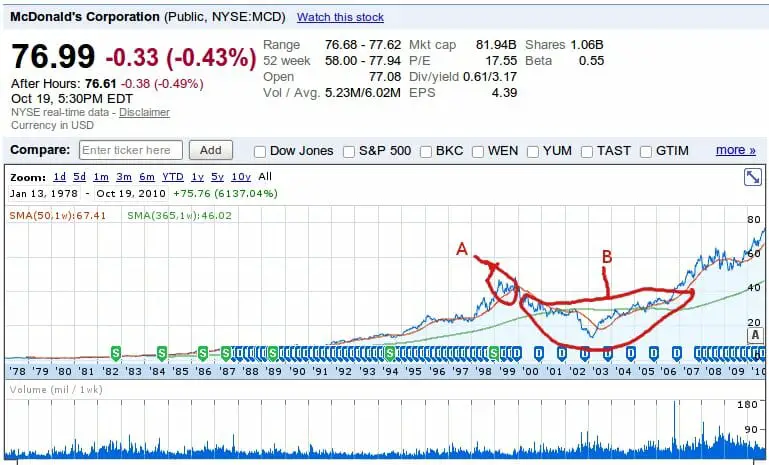
Choosing stock prices might sound impossible, but it is integral to your investment strategy.
When someone is new to investing, it can be tempting to buy anything right away.
Maybe you’ve researched a stock so much that you know it as well as you know your own brother, but you must have discipline. What we are talking about is choosing stock prices instead of impulse buying.
Investing Basics: Overvalued Stocks Happen
It doesn’t matter how good a stock is, it can be overvalued. You can look at a number of top stocks today and see that they are overvalued. I have trouble purchasing stocks that are pushing P/E ratios of 20 – 25, but look at this little list right here:
| Ticker | Company | P/E |
| VZ | Verizon | 124.54 |
| KR | Kroger | 729.56 |
| H | Hyatt Hotels | 356.09 |
| AMZN | Amazon | 67.6 |
| LUV | Southwest Airlines | 42.51 |
Now, P/E ratio isn’t necessarily indicative of a huge problem, or even overvaluation necessarily, but I avoid high P/E ratios. High P/E ratios could mean that a stock’s price is being run up by overly optimistic investors. Which is partly what happened to Facebook’s IPO.
Choosing Stock Prices, How?
Establish disciplinary guidelines for your investments. Are you investing for dividends? Choose a starting dividend yield requirement (3% is my bare minimum). Have you been watching a stock? Choose a price that you want to buy it at and set a limit order. Don’t let the market choose the price for you.
Stock Valuation
Of course, you’ll want to perform some stock valuation so you aren’t just guessing at a number, but you get the idea. If a little bad news has come out, let the stock price react a bit and place your limit order.
Choosing Stock Prices- in action
Here is an illustration of what choosing stock prices can do for you. If you look at my crudely circled “Area A” you’ll see a bunch of people who purchased because they wanted the stock now.
If they had set a price and let the money pile up in their accounts for about a year or two, they could have purchased a boat load more in “Area B.” Of course, it requires a lot of discipline to invest like this, but it will pay off. Be sure to set realistic price targets or else you could miss out entirely, but no stock moves upward indefinitely.

Set Guidelines & Stick to Them
Like everything else, rules are necessary. Investing is no different. Set your guidelines and stick to them. It is hard to watch a run up in a stock and think “I’m missing the boat!” But chasing returns is a losing endeavor, and you will rarely have a good investing experience doing this.
Figure out a P/E ratio that you are happy with, figure out a dividend yield that you like, compare the stock to their competitors and try to spot good value. Is an irrational sell-off occurring? Then take advantage of it, and purchase the stock on the cheap.
If you set some limit orders for prices you think are fair, then at the moment when people are running away from the stock and selling at undervalued prices you’ll be able to scoop them up. Ultimately, successful investing will mean being uncomfortable, and buying when others think you’re crazy (not always, but often). With that said, I will leave you with some quotes to ponder. I will attribute them as well as I can.
Quotes
“I don’t look to jump over 7-foot bars: I look around for 1-foot bars that I can step over.”
– Warren Buffett“Look at market fluctuations as your friend rather than your enemy; profit from folly rather than participate in it.”
– Warren Buffett“The investor of today does not profit from yesterday’s growth.”
– Warren Buffett“We simply attempt to be fearful when others are greedy and to be greedy only when others are fearful.”
– Warren Buffett“The time to buy is when there is blood in the streets.”
– Baron Rothschild
Choosing stock prices can make all the difference.
This article is a part of our free Stocks that Pay Dividends Training Course. Check it out now!